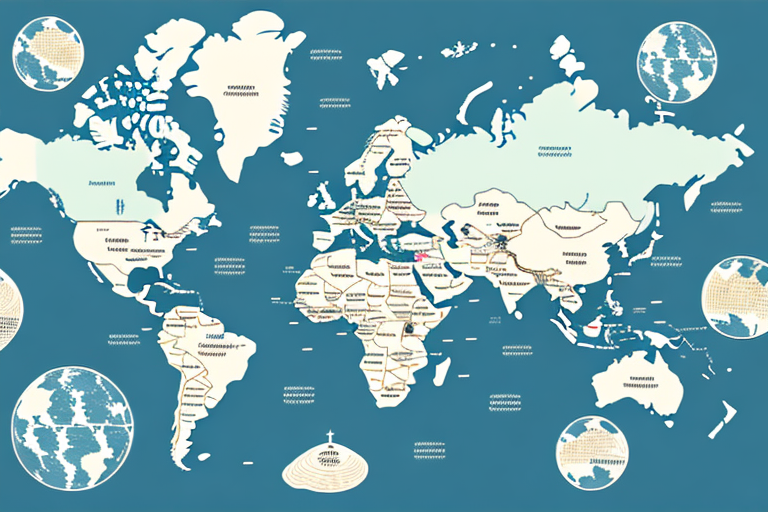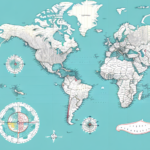Understanding UPS Shipping Rates with an Interactive Map
Shipping rates can significantly impact your business's bottom line. Understanding how UPS shipping rates work is crucial for lowering your shipping costs without compromising delivery standards. In this comprehensive guide, we'll cover everything you need to know about UPS shipping rates, including the different types of shipping options, factors that affect shipping rates, and how to use an interactive map to compare UPS shipping rates across regions.
Why UPS Shipping Rates Matter for Your Business
Shipping rates are one of the most significant expenses for eCommerce businesses, often accounting for 20-30% of total operating costs[1]. UPS, one of the leading global package delivery companies, offers a broad range of shipping options to suit your needs and budget. However, the cost of shipping varies depending on several factors such as package size, weight, delivery location, and the type of service you choose.
It's essential to understand how UPS shipping rates can impact your business's bottom line. High shipping costs can eat into your profits, making it challenging to remain competitive in the market. On the other hand, low shipping rates can help you attract more customers and increase sales.
Moreover, UPS offers various tools and resources to help you manage your shipping costs effectively. For instance, you can use their shipping calculator to estimate the cost of shipping your package based on its weight, dimensions, and destination. Additionally, UPS’s shipping software can help streamline your shipping process and reduce costs.
How to Use the UPS Shipping Rate Calculator
UPS provides a user-friendly shipping rate calculator on its website. The calculator takes into account your package's dimensions, weight, and delivery location, providing an estimated shipping cost. Keep in mind that this is only an estimate, and the final cost may vary depending on the actual weight and dimensions of your package.
When using the UPS shipping rate calculator, it's important to accurately measure and weigh your package. Any discrepancies in the measurements or weight can result in higher shipping costs or even a delay in delivery. Additionally, selecting the correct delivery option is crucial, as faster delivery options typically come with higher costs.
Furthermore, UPS offers discounts for frequent shippers and those who utilize their online shipping tools. Exploring these options can help you save money on your shipping costs. Lastly, ensure that your items are properly packaged to guarantee they arrive safely and securely at their destination.
The Benefits of an Interactive Map for UPS Shipping Rates
An interactive map can help you determine the cost of shipping to different regions by entering your package details. The map provides clear visuals of the shipping rates for UPS's different services and allows you to compare rates across various regions seamlessly. This information is particularly helpful when deciding which shipping service to use for different package weights and destinations.
Additionally, an interactive map can provide estimated delivery times for each shipping service, giving you a better idea of when your package will arrive at its destination. This is especially useful for time-sensitive shipments or when planning for important events. By easily comparing rates and delivery times, an interactive map can save you time and money when shipping with UPS.
The Different Types of UPS Shipping Rates
UPS shipping rates vary depending on the delivery location, service type, and package weight and size. The most common types of shipping services offered by UPS include UPS Ground, UPS Air, and UPS International. The rates for each of these services vary based on factors like delivery speed and the package's dimensions.
Factors That Affect UPS Shipping Rates
Several factors can affect the cost of your UPS shipments, including:
- Package weight and dimensions: Heavier and larger packages cost more to ship.
- Distance to the destination: Longer distances typically result in higher shipping costs.
- Delivery speed: Faster delivery options come with higher costs.
- Type of service: Different UPS services have varying rates based on their features.
- Fuel surcharges: UPS applies fuel surcharges to shipments when fuel prices rise, impacting shipping rates.
Another factor affecting UPS shipping rates is the value of the package being shipped. High-value packages may require additional insurance, increasing the cost of shipping. Additionally, certain items may be subject to extra fees or restrictions, such as hazardous materials or oversized items. It's important to check with UPS to ensure your package meets all requirements and to avoid unexpected fees.
How to Save Money on UPS Shipping Rates
Shipping costs can add up and impact your business's profitability. To reduce your shipping expenses, consider the following strategies:
- Optimize package size and weight: Use the smallest possible packaging to minimize weight and dimensions.
- Negotiate better rates: Sign a contract with UPS or use a third-party shipping service that consolidates shipping volume across multiple businesses.
- Utilize discounts and promotions: UPS offers discounts for frequent shippers and specific industries, such as healthcare and education. Additionally, they often run promotions during peak seasons like holidays.
- Choose the right delivery option: If your package doesn't need urgent delivery, opt for slower shipping methods to save costs.
- Schedule shipments during off-peak times: Shipping during early in the week or early in the day can result in lower rates.
Understanding the Differences Between Ground, Air, and International Shipping Rates
UPS offers various shipping services tailored to different package sizes, weights, delivery times, and international destinations. UPS Ground is the most cost-effective shipping option but has longer delivery times. UPS Air offers faster delivery at higher costs, while UPS International is designed for shipments going outside the US and caters to non-contiguous territories.
Rates for each shipping option can vary based on the distance the package needs to travel, the package's weight, and the level of service selected. Additionally, UPS offers extra services such as signature confirmation, insurance, and Saturday delivery for an additional fee. Carefully consider your shipping needs and budget when selecting a shipping option and any additional services.
Tips for Negotiating Better UPS Shipping Rates
If you frequently ship large volumes of packages through UPS, negotiating a lower shipping rate may be beneficial. Here are some tips to help you secure better rates:
- Research prevailing shipping rates: Understand the standard rates in your industry to negotiate effectively.
- Bundle shipments: Consolidate shipments to increase your volume, which can lead to discounted rates.
- Prepay shipping: Committing to a certain volume can help secure lower rates.
- Explore alternative shipping options: Consider using different carriers for specific types of shipments or utilize third-party logistics providers.
- Build a strong relationship with your UPS account representative: Regular communication about your shipping needs and volume can demonstrate your value as a customer, potentially leading to favorable pricing agreements.
Understanding Dimensional Weight and Its Impact on Shipping Costs
Dimensional weight (DIM weight) is a pricing technique used in the shipping industry to account for the space a package occupies in relation to its actual weight. It's calculated by multiplying a package's length, width, and height, then dividing by a divisor set by the carrier. For UPS, the DIM divisor is typically 139, though it may vary depending on the service level.
UPS uses dimensional weight to determine shipping rates, ensuring that lightweight but bulky packages are charged similarly to heavy and dense ones. Understanding DIM weight is essential for accurate shipping cost estimation and can help you avoid unexpected charges.
How to Choose the Best UPS Shipping Option for Your Business Needs
Choosing the best UPS shipping option for your business involves understanding your shipping needs, the size and weight of your packages, and your customers' expectations:
- Review UPS shipping services: Assess the different services available, such as UPS Ground, UPS 2nd Day Air, UPS Next Day Air, and UPS International.
- Consider delivery times and rates: Balance the need for speed with budget constraints.
- Use UPS’s interactive map: Compare rates and delivery options across different regions to make informed decisions.
- Evaluate tracking and insurance: Some UPS services provide more detailed tracking information and higher insurance coverage, which may be necessary for valuable or time-sensitive shipments.
- Account for additional fees or surcharges: Be aware of potential extra costs like fuel surcharges, residential delivery fees, or handling fees for oversized packages.
By carefully evaluating your business's shipping needs and comparing different UPS shipping options, you can ensure that your packages are delivered on time and at the most cost-effective price.
The Role of Distance and Destination in UPS Shipping Rates
The distance to the destination significantly influences UPS's shipping rates. Typically, the farther the package needs to travel, the higher the shipping cost. Additionally, factors such as the destination's population density, postal codes, and customs regulations can impact shipping rates.
Another critical factor is the weight and size of the package. Heavier and larger packages require more resources to transport and may incur additional fees. UPS also offers various shipping options, such as ground, air, and international services, each with different pricing structures. When choosing a shipping method, consider all these factors to ensure a cost-effective and efficient delivery of your package.
How to Use an Interactive Map to Compare UPS Shipping Rates Across Regions
UPS's shipping rate map is an excellent tool for comparing shipping rates across different regions. To use this map:
- Enter your package's weight and dimensions.
- Input the intended delivery destination.
- Review the range of shipping options and associated rates displayed on the map.
This visual comparison helps you choose the most cost-effective service for your business by allowing you to evaluate different shipping costs and delivery times across regions.
The Impact of Fuel Surcharges on UPS Shipping Rates
UPS applies fuel surcharges to shipping costs to help cover the fluctuating cost of fuel for their fleet of vehicles. The rate of fuel surcharges varies based on the current market cost of fuel. These surcharges can significantly impact shipping costs, especially during periods of rising fuel prices.
When pricing your products or planning your budget, it's essential to consider fuel surcharges as part of your overall shipping expenses. Staying informed about fuel price trends can help you anticipate changes in shipping costs and adjust your pricing strategy accordingly.
Common Mistakes to Avoid When Estimating UPS Shipping Rates
Accurate estimation of UPS shipping rates is crucial for budgeting and maintaining profitability. Here are common mistakes to avoid:
- Incorrect package weight and dimensions: Ensure that you have precise measurements and weigh your packages accurately. Inaccurate data can result in incorrect shipping quotes or shipment rejections.
- Misunderstanding shipping destination: Verify the postal codes and address details of the shipping destination to avoid incorrect rates and delivery delays.
- Overlooking additional fees: Be aware of potential extra costs such as fuel surcharges, residential delivery fees, and handling fees for oversized items.
- Ignoring DIM weight: Consider dimensional weight when estimating shipping costs to avoid unexpected charges for bulky but lightweight packages.
By understanding the factors that affect UPS shipping rates and utilizing interactive resources like the UPS shipping rate map, you can make informed and cost-effective shipping decisions for your business.








